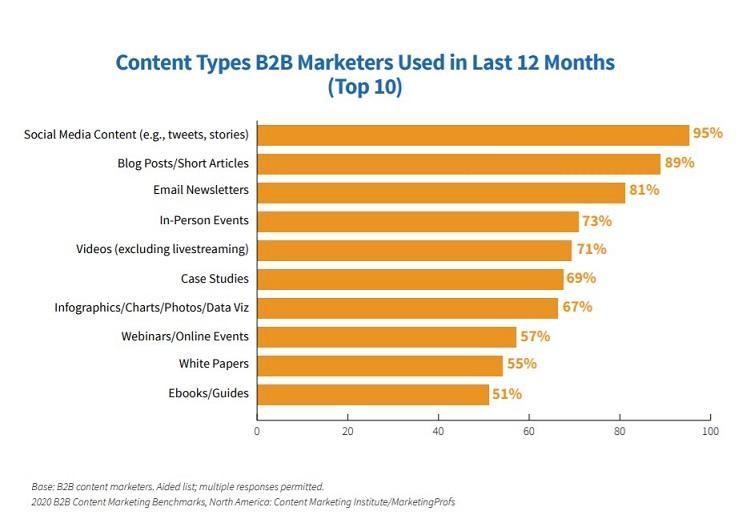Writing great content takes time and effort. Get it right and you’ll boost your SEO rankings, gain traffic to your website, engage visitors and generate more leads. Remember you need to create content that your audience wants to read, and also what Google wants. You should also understand that Google will penalize sites with duplicate content, but loves sites that contain original content. So, here are 7 tips to help you achieve content success.
Customer engagement depends on the right content
According to Gartner, marketing teams spend roughly 30% of their budgets on creating content. Creating different types of content to attract, engage, and convert customers. Sadly, less than 40% have a defined and documented content strategy.
Content fuels every customer experience and interaction. Effective content will differentiate your business and naturally engage your target audience. And best of all, help you win more of your dream customers.
A warning as you embark on creating content for your business: content marketing can take time to show real results. But, when you get it right you see strong, long-term results.
1. Create original content
Easier said than done. Creating content that is truly original is tough. Don’t be tempted to copy others, as Google will penalise you for this.
Its true there are probably some common themes and topics that are of interest to your target audience, but can you approach them in a more original or alternative way? Think about those problems that your audience are facing, and help provide solutions to those problems, or alternative ways of dealing with the problem. When someone reads your content, make them feel they have learnt something in the process, that way they’ll come back again and again.
2. Educate with your content
According to The Content Institute the majority of B2B content marketers use educational content to help nurture and engage their audiences. Building trust and credibility through sharing content of value.

Source: Content Marketing Institute
Most of us don’t even consider the question “whats the purpose of a search engine?” we instinctively know: to find an answer to a question. We know Google is great at this, you type in your question and you get a series of results with links, images and videos.
Wouldn’t it be great to see your content show up in these results as the answer to a question? That’s your goal. You should also remember that often people want immediacy, they want answers fast, so make your content easy to skim read.
Create content that is giving value, is relevant, authoritative, providing answers and educates.
3. Focus on quality for content success
Creating well-written, quality content is really important, when you realise that 60 percent of consumers won’t purchase from a brand with poorly written content. According to Neil Patel, compelling copy draws 7.8 times more site traffic and produces higher brand recall which brings higher engagement rates.
Google also monitors and rewards quality content. In Blue Corona’s blog they’ve provided some great context on this.
Don’t be tempted to try and cover too many keywords as this will diminish readability for your audience. The primary goal is to deliver valuable, engaging content that encourages your audience to come back. If its useful, your audience will stay longer and come back, which is a positive signal to Google that your website is full of great and useful content. This will help your rankings and also help reduce your bounce rate.
For those interested in digging into Googles guidelines on quality, check out their webmaster guidelines.
4. Add images and video
Humans are very visual creatures which means that by adding image or video you will improve the communication with your audience.
We all learn differently, but regardless of your learning style, readability is improved by adding images, video’s and diagrams. Visual aids can also more clearly illustrate your point. The increasing use of social media channels like Instagram and Pinterest demonstrate how successful use of image can be.
Adding images and headers to break up the text, will really help those who are time-poor and skim readers. The use of headers and bullet points also aid easy readability. Don’t’ be tempted to add too many images.
5. Be accurate and honest with referencing and sourcing of information
What you write needs to be accurate, credible and believable. If your brand is less well known then your content is helping build trust and credentials which means using references to substantiate your comments and thoughts.
Using a combination of referenced statistics and sources is great, use your own too, but say they are your own. Add links in your content to the source. This builds trust with your readers: they’ll start to see you as a credible source.
- Consider who you are linking to. Are you using trusted and authoritative sources? Are they recognised in their field?
- Consider the age of the reference or statistic. If the date is old, check if its still relevant. Using old references can adversely reflect on the quality, but if its still valid – say so
- Linking to more content will help. The more you can back up and substantiate what you are writing about, the more trusted your content will become.
- Help the search engines out.Linking to other sources and content will help the search engines figure out what your content is about, and how it should be categorized.
All of this points to the benefits of putting energy into doing research to create original and meaningful content. Although it can be time consuming, its worth it. Focus on publishing quality content, regularly: its worth the investment.
6. Create powerful headlines
A great headline will draw in your audience. These stats from Copyblogger really highlight the importance of how a headline can make or break great content.
- 80% of people will read your headlines
- Only 20% will read the rest of your content
The title is the first thing people will read, so as you build your content, invest time in creating a headline that grabs the attention of your audience. Brainstorm a few ideas, before finally selecting your title. Also think about A/B testing with titles.
Neil Patel has a great blog on how to create powerful headlines – check it out.
7. Regular and consistent
Committing to creating content requires an investment of time and resources. Starting a blog, or creating other types of content may feel onerous, but don’t give up after you’ve created a couple. You won’t engage your target audiences and get them coming back if you are not regularly updating your website or blog with content.
Search engines favour websites that are being regularly updated with content.
If you’re just setting out, don’t over commit, set yourself a target that’s achievable. Commit to one piece of content per week or per month – dependent on your resources. The goal is to regularly create and deliver new content for your business. Do this consistently and your audience will follow and you’ll achieve content success.
Some final pointers on content success
Don’t be put off. Achieving content success does require time and effort but the investment is worth it. Producing good quality content, regularly will deliver dividends across your full customer life cycle.
Content success is a win win for your business. Success with website rankings and google placements and success with attracting, engaging and winning customers.
If you need any support or guidance in creating content or building a successful content strategy that delivers results, have a chat with us hello@intelligentmarketing.uk.com






